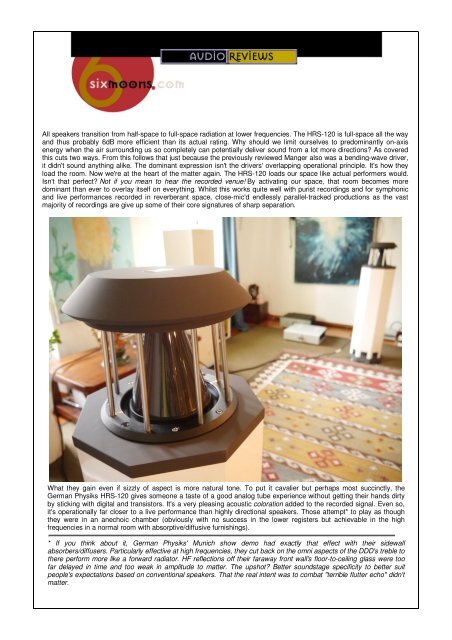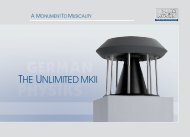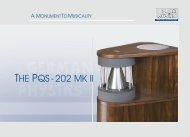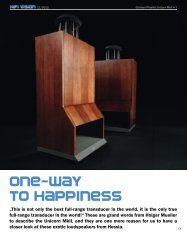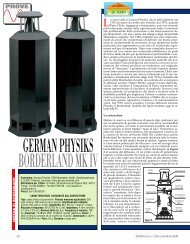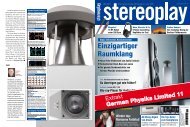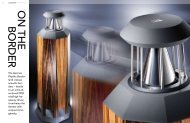Download 6Moons test report. July 2013 (PDF). - German Physiks
Download 6Moons test report. July 2013 (PDF). - German Physiks
Download 6Moons test report. July 2013 (PDF). - German Physiks
You also want an ePaper? Increase the reach of your titles
YUMPU automatically turns print PDFs into web optimized ePapers that Google loves.
All speakers transition from half-space to full-space radiation at lower frequencies. The HRS-120 is full-space all the way<br />
and thus probably 6dB more efficient than its actual rating. Why should we limit ourselves to predominantly on-axis<br />
energy when the air surrounding us so completely can potentially deliver sound from a lot more directions? As covered<br />
this cuts two ways. From this follows that just because the previously reviewed Manger also was a bending-wave driver,<br />
it didn't sound anything alike. The dominant expression isn't the drivers' overlapping operational principle. It's how they<br />
load the room. Now we're at the heart of the matter again. The HRS-120 loads our space like actual performers would.<br />
Isn't that perfect? Not if you mean to hear the recorded venue! By activating our space, that room becomes more<br />
dominant than ever to overlay itself on everything. Whilst this works quite well with purist recordings and for symphonic<br />
and live performances recorded in reverberant space, close-mic'd endlessly parallel-tracked productions as the vast<br />
majority of recordings are give up some of their core signatures of sharp separation.<br />
What they gain even if sizzly of aspect is more natural tone. To put it cavalier but perhaps most succinctly, the<br />
<strong>German</strong> <strong>Physiks</strong> HRS-120 gives someone a taste of a good analog tube experience without getting their hands dirty<br />
by sticking with digital and transistors. It's a very pleasing acoustic coloration added to the recorded signal. Even so,<br />
it's operationally far closer to a live performance than highly directional speakers. Those attempt* to play as though<br />
they were in an anechoic chamber (obviously with no success in the lower registers but achievable in the high<br />
frequencies in a normal room with absorptive/diffusive furnishings).<br />
* If you think about it, <strong>German</strong> <strong>Physiks</strong>' Munich show demo had exactly that effect with their sidewall<br />
absorbers/diffusers. Particularly effective at high frequencies, they cut back on the omni aspects of the DDD's treble to<br />
there perform more like a forward radiator. HF reflections off their faraway front wall's floor-to-ceiling glass were too<br />
far delayed in time and too weak in amplitude to matter. The upshot? Better soundstage specificity to better suit<br />
people's expectations based on conventional speakers. That the real intent was to combat "terrible flutter echo" didn't<br />
matter.


